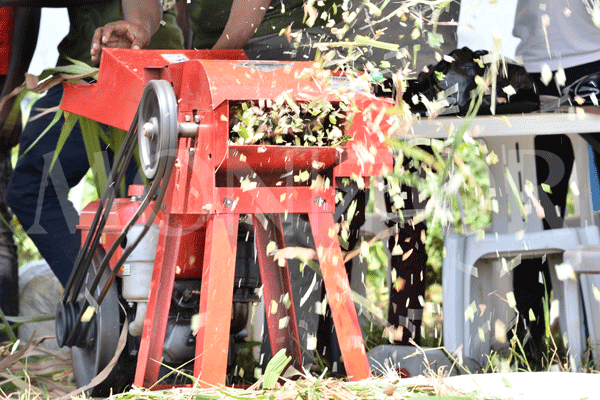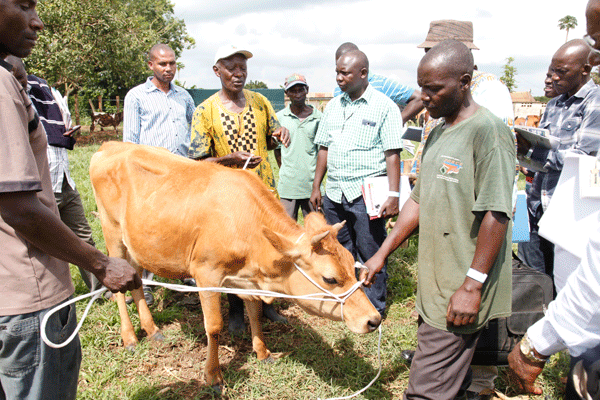How to make silage more palatable

A forage chopper is a must-have machine for smallholder livestock farmers to make feed palatable. PHOTO/GEORGE KATONGOLE
What you need to know:
- Silage is increasingly becoming necessary for livestock farmers given the vulnerability of weather changes. Making it right is important.
In intensive cattle production systems, silage is the insurance farmers need for their feeding needs.
According to livestock experts, away from grazing, feed storage for deferred use both as hay and silage is an effective option.
Silage is derived from any green plant material put in a place where it can ferment in the absence of air. When green fodders are in plenty they are conserved as silage to meet the demand of good quality fodder during lean season.
Silage is preserved more or less in its original condition, with minimum deterioration and minimum loss of nutritive constituents of fodders. The process of conserving green fodder is called as ensilage.
During ensiling, fermentation of sugars forms acids and breaks down some of the forage proteins into simpler compounds.
“Animals need varying energy sources at different stages,” Brian Owoyesigire, a livestock scientist in the National Agricultural Research Organisation (Naro) based at Buginyanya Zonal Agricultural Research and Development Institute (BugiZardi).
Advantages
Silage is important in conserving the pasture. According to Dr Owoyesigire, crops can be ensiled when the weather does not permit curing them into hay or dry fodder.
Dr Owoyesigire explains that crops rich in soluble sugars such as maize, alfalfa, soybean, sorghum, oats, pearl millet, and hybrid Napier are most suitable for fodder ensiling. Cultivated and natural grasses can be ensiled with addition of 3-3.5 per cent molasses.
Dr Owoyesigire says that crops should be harvested between flowering and milk stage. In general, crops with thick stems are conserved in form of silage while thin stemmed crops are conserved as hay.
Delaying harvest for silage especially when a crop is drier, will open the door to increased fibre levels in plant tissue that can cause digestibility to decline.
“We know the animal needs certain amounts of protein and that protein has to be available to the animal. Forage at the right time then packaged appropriately and in good condition can quite easily provide the nutrient needs cattle will require.”
Palatability
But researchers are continuously exploring options of maximising feed intake by animals with palatability at the forefront.
Palatability determines what animals will prefer over a different option. A more palatable item will be enjoyed, while a less palatable one may be ignored. Palatability is determined by a number of factors, including taste, texture in the mouth and smell.
Dr Laban Buye another livestock expert at BugiZardi says that palatable feed does more than taste good to an animal.
“The more palatable the feed, the more likely an animal will consume it, contributing to a higher rate of gain to the farmer,” he says.
Feed companies have produced inoculants to increase feed intake and in turn, animal performance.
Dr Buye explains that animals rely on their sense of smell and taste to evaluate desirable feed.
When feedstuffs have an unpleasant smell and taste, feed intake will be low increasing waste,” he says.
Therefore, ensuring quality silage is key in improving feed intake and animal performance.
Best practices
With the high value of harvested forages and feeds today, it only makes sense to invest the effort to do the job right.
There is some loss of dry matter and nutrients during the ensiling process. However, during the process of harvesting and ensiling, there are management practices that need to be followed to minimise those losses.
Dr Buye explains that harvesting a crop at optimal moisture content can reduce the loss of dry matter and valuable nutrients. Harvesting crops with too much moisture leads to losses in effluent such as plant sugars, soluble proteins and some vitamins and minerals, while harvesting with too little will lead to a restricted fermentation.
Silage making
The making of silage goes through four major phases after the material has been harvested. It should then immediately be chopped, compacted and sealed before ensiling.
The first phase stage is to ensure sealing of the storage bag or pit for proper preservation. The choice of the storage bags or pits is largely determined by the number of cows to be fed and the length of the feeding period.
In pits, at the top fodder should be packed 3-4 feet above ground level. It should be covered with poor quality grasses on all sides and then covered with wet mud or dung to seal and prevent entry of air and water. The layer may be about 4-5 inches thick.
In producing silage, the right equipment is just part of the equation. Traditionally, livestock keepers have used pangas to chop the forage but experts advise on using forage choppers.
“Because the machine can cut the desired pieces of 1-3cm while eliminating accidents,” Dr Owoyesigire says.
The silage undergoes fermentation which takes several days to weeks. Silage would be ready in two months. When temperature in the silo is moderate, silage tends to be yellowish or brownish green and sometimes even golden in colour. Very good silage has acidic taste and smell, is free from mould.



